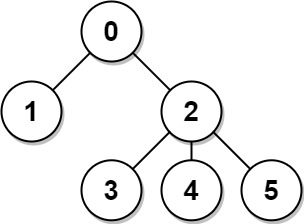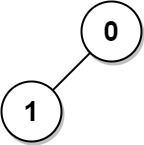834.Sum of Distances in Tree
===
###### tags: `Hard`,`DFS`,`DP`,`Tree`,`Graph`
[834. Sum of Distances in Tree](https://leetcode.com/problems/sum-of-distances-in-tree/)
### 題目描述
There is an undirected connected tree with `n` nodes labeled from `0` to `n - 1` and `n - 1` edges.
You are given the integer `n` and the array `edges` where `edges[i]` = [$a_i$, $b_i$] indicates that there is an edge between nodes $a_i$ and $b_i$ in the tree.
Return an array `answer` of length `n` where `answer[i]` is the sum of the distances between the i^th^ node in the tree and all other nodes.
### 範例
**Example 1:**

```
Input: n = 6, edges = [[0,1],[0,2],[2,3],[2,4],[2,5]]
Output: [8,12,6,10,10,10]
Explanation: The tree is shown above.
We can see that dist(0,1) + dist(0,2) + dist(0,3) + dist(0,4) + dist(0,5)
equals 1 + 1 + 2 + 2 + 2 = 8.
Hence, answer[0] = 8, and so on.
```
**Example 2:**

```
Input: n = 1, edges = []
Output: [0]
```
**Example 3:**

```
Input: n = 2, edges = [[1,0]]
Output: [1,1]
```
**Constraints**:
* 1 <= `n` <= 3 * 10^4^
* `edges.length` == `n` - 1
* `edges[i].length` == 2
* 0 <= $a_i$, $b_i$ < `n`
* $a_i$ != $b_i$
* The given input represents a valid tree.
### 解答
#### Python
```python=
class Solution:
def sumOfDistancesInTree(self, n: int, edges: List[List[int]]) -> List[int]:
from collections import defaultdict
dict_node2edge = defaultdict(list)
self.dict_visit = defaultdict(list)
for e in edges:
dict_node2edge[e[0]].append(e[1])
dict_node2edge[e[1]].append(e[0])
self.dict_visit[ (e[0],e[1]) ] = 0
self.dict_visit[ (e[1],e[0]) ] = 0
def dfs(node):
currentnode_subtree_distance = 0
node_cnt = 1
father = node
#print('current node', node)
for child in dict_node2edge[father]:
if self.dict_visit[ (father,child) ] or self.dict_visit[ (child,father) ]:
continue
self.dict_visit[ (father,child) ] = 1
self.dict_visit[ (child,father) ] = 1
dist, nc = dfs( child )
currentnode_subtree_distance += dist
node_cnt += nc
self.node_parentnode[child] = father
self.childs[father].append(child)
self.subtree_distance[node] = (currentnode_subtree_distance , node_cnt)
#print('dfs', node, currentnode_subtree_distance, node_cnt)
return currentnode_subtree_distance + node_cnt, node_cnt
#Set 0 node as root
#layer by layer calculate sub tree layer
self.subtree_distance = dict() #know each node's subtree stat
self.childs = dict() #know where to find node's edge
for i in range(n):
self.childs[i] = []
self.node_parentnode = dict() #know who is your parent
self.edge_visit = [0] * len(edges)
ans = dict()
a, b = dfs(0)
ans[0] = a - b
nodes = [0]
while len(nodes) != 0:
node = nodes.pop()
nodes = self.childs[node] + nodes
if node == 0:
continue
else:
#print(node, self.node_parentnode[node])
#print(ans[ self.node_parentnode[node] ])
#print(self.subtree_distance[node])
ans[node] = ans[ self.node_parentnode[node] ] + n - 2*(self.subtree_distance[node][1])
#print(node, ans[node])
return [ans[node] for node in range(n)]
```
> [name=玉山][time=Thu, Dec 26, 2022]
```python=
class Solution:
def sumOfDistancesInTree(self, n: int, edges: List[List[int]]) -> List[int]:
res = [0] * n
cnt = [1] * n
graph = [[] for _ in range(n)]
for a, b in edges:
graph[a].append(b)
graph[b].append(a)
def dfs1(node = 0, parent = -1):
for child in graph[node]:
if child == parent: continue
dfs1(child, node)
cnt[node] += cnt[child]
res[node] += res[child] + cnt[child]
def dfs2(node = 0, parent = -1):
for child in graph[node]:
if child == parent: continue
res[child] = res[node] - 2*cnt[child] + n
dfs2(child, node)
dfs1()
dfs2()
return res
```
> [name=Yen-Chi Chen][time=Thu, Dec 22, 2022]
#### C++
```cpp=
class Solution {
public:
vector<vector<int>> tree;
vector<int> res, count;
void dfs1(int root, int parent = -1) {
for (int child : tree[root]) {
if (child == parent) continue;
dfs1(child, root);
count[root] += count[child];
res[root] += res[child] + count[child];
}
}
void dfs2(int root, int parent = -1) {
for (int child : tree[root]) {
if (child == parent) continue;
res[child] = res[root] - 2*count[child] + count.size();
dfs2(child, root);
}
}
vector<int> sumOfDistancesInTree(int n, vector<vector<int>>& edges) {
tree.resize(n);
res.assign(n, 0);
count.assign(n, 1);
for (const auto& edge : edges) {
tree[edge[0]].push_back(edge[1]);
tree[edge[1]].push_back(edge[0]);
}
dfs1(0);
dfs2(0);
return res;
}
};
```
> [name=Yen-Chi Chen][time=Thu, Dec 22, 2022]
#### Javascript
一樣TLE我好爛
```javascript=
function sumOfDistancesInTree(n, edges) {
const graph = [];
for (const [v1, v2] of edges) {
graph[v1] = graph[v1] ?? [];
graph[v2] = graph[v2] ?? [];
graph[v1].push(v2);
graph[v2].push(v1);
}
const distances = new Array(n).fill(0);
for (let i = 0; i < n; i++) {
const visited = new Array(n).fill(false);
const stack = [[i, 0]];
// 做DFS 依序累加距離
while (stack.length) {
const [node, step] = stack.pop();
if (visited[node]) continue;
visited[node] = true;
if (graph[node] === undefined) continue; // 沒有相鄰的點
for (const vertex of graph[node]) {
if (visited[vertex]) continue;
distances[i] += step + 1;
stack.push([vertex, step + 1]);
}
}
}
return distances;
}
```
> [name=Marsgoat][time=Thu, Dec 22, 2022]
```javascript=
function sumOfDistancesInTree2(n, edges) {
const graph = new Array(n).fill(0).map(() => []);
for (const [v1, v2] of edges) {
graph[v1].push(v2);
graph[v2].push(v1);
}
const distances = new Array(n).fill(0);
const counts = new Array(n).fill(1);
function dfs(node, parent) {
for (const vertex of graph[node]) {
if (vertex === parent) continue;
dfs(vertex, node);
counts[node] += counts[vertex];
distances[node] += distances[vertex] + counts[vertex];
}
}
function dfs2(node, parent) {
for (const vertex of graph[node]) {
if (vertex === parent) continue;
distances[vertex] = distances[node] - counts[vertex] + n - counts[vertex];
dfs2(vertex, node);
}
}
dfs(0, -1);
dfs2(0, -1);
return distances;
}
```
> 感謝吉神教學,終於看懂了
> [name=Marsgoat][time=Jan 5, 2023]
### Reference
吉神教學

> 吉神:
> 經過第一次DFS之後我們有跟節點到所有點的距離總和了
> 此時如果想要再一次DFS就完工的話,就要去想,從某一個點下來時,結果會怎麼改變?
> 從圖上來看,當我們從原先的a點走到b點時,跟a點所在的藍色區域中所有的點的距離都多了1,跟綠色區域中所有的點的距離都少了1
> 藍色區域的數量又等於`n - 綠色區域的數量`
> 所以我們就有`ans[b]` = `ans[a]` + `n` - 2*`count[a]`
> 把算法列出來,這題就簡單了
[回到題目列表](https://hackmd.io/@Marsgoat/leetcode_every_day)
 Sign in with Wallet
Sign in with Wallet
 Sign in with Wallet
Sign in with Wallet